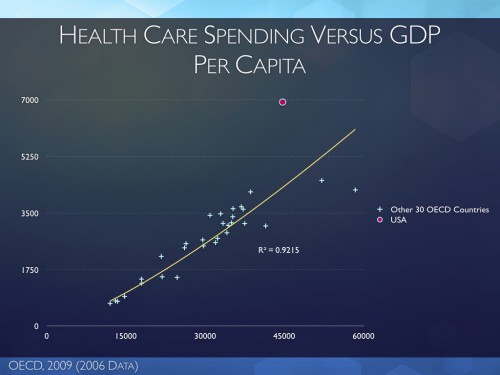Matt Yglesias points out that health care costs have to go up, since something has to go up when you’ve got more to spend. Austin adds his take on this here.
I don’t disagree with the premise of what Matt is saying. Of course, when you have more money, you’re going to spend more on health care. Richer countries should spend more money on health care, just as they spend more money on everything else. The question is how much more? So let me show you this slide for a class I’m teaching this afternoon, made from OECD data:
What you are looking at is GDP per capita on the x-axis, and health care spending per capita on the y-axis. It makes sense that countries with more money (in GDP) will spend more on health care. In fact, that’s what happens. The 30 non-US OECD countries line up in a pretty good line, with increasing spending per person as their GDP gets higher. In fact, as I show in the chart, you can make a pretty good line that fits the relationship between GDP and health care spending.
Notice two things, however. The first is that Norway and Luxembourg (the two countries farthest to the right), fall below the line. This is because – presumably – at some point you can spend more money, but what’s the point? The drugs won’t work better, the advice is still the same, and the doctors can’t do any more. At some point, spending more is just waste, because the outcomes don’t get any better.
The second thing to notice is the US. You can’t miss it. It’s the big red dot that’s way at the top. We’ve chosen to ignore what I just said.
It’s not that we shouldn’t spend more than other countries. We should. We are richer than almost anyone, and we should spend more on health care. The problem is that we’re spending so much more than everyone else, even after taking into account our GDP. We’re literally off the chart. And we’re not getting better outcomes for that money.

